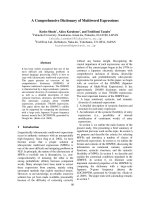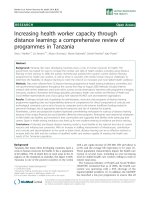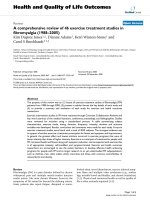A comprehensive review of catheter associated urinary tract infections pathogenesis, risk factors, clinical and laboratory features and contribution to hospital costs, morbidity an
Bạn đang xem bản rút gọn của tài liệu. Xem và tải ngay bản đầy đủ của tài liệu tại đây (577.74 KB, 72 trang )
Catheter-associated urinary tract infection - 1
1. INTRODUCTION:
Catheter-associated urinary tract infection (CAUTI) is the most common
nosocomial infection in hospitals and nursing homes worldwide, comprising
more than 40% of all institutionally-acquired infections.(Stamm, 1991; Warren
1991; Kunin 1997). Up to 25% of patients requiring a urinary catheter for
seven days or longer develop nosocomial bacteriuria or candiduria, with a daily
incidence of 5% (Garibaldi et al 1982; Kunin 1997). CAUTI rarely progress to
bloodstream infection. However, overall, CAUTI is the second most common
cause of nosocomial bloodstream infection because of the high frequency of
this infection. (Maki 1981; Krieger et al 1983; Bryan and Reynolds 1984)
Studies by Platt et al (1982) and Kunin et al (1992) suggest that nosocomial
CAUTIs are associated with increased institutional mortality, unrelated to the
occurrence of urosepsis. Asymptomatic urinary tract infections often precipitate
unnecessary antimicrobial therapy. CAUTIs comprise perhaps the largest
institutional reservoir of nosocomial antibiotic-resistant pathogens.(Stamm
1991; Jarvis and Martone 1992; Siebert et al 1993; Jarlier et al 1996).
The recognition of the role of the catheter in the pathogenesis of urinary tract
infections dates back to the 1950s (Kass 1956). Most of what we know about
CAUTI derives from studies done in the early 1970s and 1980s soon after the
introduction of infection control programs in the United States and elsewhere.
Catheter-associated urinary tract infection - 2
This was before the widespread changes in healthcare associated with the
managed care era - increases in technology and the pressure towards early
discharge and outpatient management of increasingly sicker patients. (Warren
1991; Kunin 1997). Very little is known about the exact pathogenesis,
symptomatology, association with pyuria and mortality as well as economic
impact in the modern era. This study was undertaken to try to address some of
these gaps.
Catheter-associated urinary tract infection - 3
2. AIMS:
2.1 Pathogenesis:
Excluding rare hematogenously-caused pyelonephritis, mainly with S.aureus
(Lee et al 1978; Arpi and Renneberg 1984) the vast majority of microorganisms
causing endemic CAUTI are thought to derive from patients’ own perineal flora
or from the hands of healthcare personnel inserting the catheter or manipulating
the collection system.(Stamm, 1991; Warren 1991). These organisms are
thought to gain access to the bladder by one of two mechanisms: extraluminally
- early, by direct inoculation at the time of catheter insertion or later, ascending
from the perineum in the mucus film contiguous to the external catheter surface;
or intraluminally, most probably by reflux of organisms gaining access to the
catheter lumen from failure of closed drainage or contamination of collection
bag urine. The relative contribution of each of the three routes has not been
adequately delineated. Strategies for prevention, especially technologic
innovations, should be guided by the best understanding of pathogenesis.
The first aspect of this large prospective study encompassing 1497 evaluable
newly catheterized patients was undertaken to better define the pathogenesis of
CAUTI.
Catheter-associated urinary tract infection -
4
2.2 Risk factors:
A small number of prospective studies (Garibaldi et al 1974; Shapiro et al 1984;
Platt et al 1986; Johnson et al 1990) examined the risk factors for CAUTI
mainly in the 1970s and 1980s. The current era’s strong focus on compliance
with published infection control guidelines, the effect of compliance with the
individual aspects of catheter care has not been adequately examined.
Therefore, the second part of this large prospective observational study of
CAUTI was to study risk factors for CAUTI, particularly the impact of non-
compliance with recommended precepts of urinary catheter care on the risk of
CAUTI.
2.3. Clinical Features and Symptoms associated with CAUTI
Although there have been recommendations to treat catheter-associated
urinary tract infections only when symptomatic (Warren 1991; National Institute
on Disability and Rehabilitation Research 1992; O’Grady et al 1998), the
symptoms associated with CAUTI have not been clearly defined. The third part
of this prospective study of 1497 newly-catheterized hospitalized patients was
undertaken to determine the prevalence of signs and symptoms attributable to
Catheter-associated urinary tract infection -
5
CAUTI and the relative contribution of CAUTI to nosocomial bloodstream
infection.
2.4 Association with Pyuria:
Pyuria has been shown to have excellent predictive value for identifying
urinary tract infections in non-catheterized patients (Mabeck 1969,
Stamm et al 1981).
Although published guidelines recommend using
pyuria as the criterion for obtaining a urine culture as part of the work-up
of fever in the hospitalized patient (O’Grady et al 1998), the utility of
pyuria to identify bacteriuria or candiduria in short-term catheterized
patients has not been clearly defined previously.
The fourth part of this prospective study was to determine the
relationship between pyuria and urinary tract infection in 761 hospitalized
patients with short-term indwelling urinary catheters.
2.5. Mortality and Morbidity:
The contribution of CAUTI to hospital mortality has not been clearly defined. In
a widely cited study published in 1982, Platt et al reported that nosocomial
CAUTIs were associated with greatly increased in-hospital mortality in
Catheter-associated urinary tract infection -
6
catheterized patients. (Platt et al 1982). Subsequently, Kunin et al reported a
strong association between use of urinary catheters and mortality in nursing
home patients. (Kunin et al 1992).
We reexamined this association in a prospective analysis of one thousand
catheterized hospitalized patients to determine whether CAUTI is truly an
independent predictor of increased hospital mortality.
2.6. Economic Impact:
Retrospective studies quantifying the economic impact of CAUTI were done
mainly in the 1970s and 1980s, (Scheckler 1979; Givens and Wenzel 1980;
Haley et al 1981; Coello et al 1993)
before the widespread emergence of
resistant nosocomial uropathogens and also before the advent of managed
care in US hospitals.
In the final part of the analysis, we prospectively studied 1497 newly-
catheterized hospitalized patients, obtaining daily urine cultures, and quantified
the extra direct costs of hospitalisation incurred in the management of CAUTI in
123 infected patients, and compared the findings with those of earlier studies in
the 1970s and 1980s before the era of managed care.
Catheter-associated urinary tract infection -
7
3. METHODS:
3.0 Methods in Common to all six sections:
3.0.1 Patients:
All patients hospitalized at the University of Wisconsin Hospital and Clinics or
the William S Middleton Veterans Administration Medical Center, in Madison,
WI, USA, scheduled to receive an indwelling urethral (Foley) catheter, who
could be successfully catheterized with a 16Fr or 18Fr catheter and were
expected to be catheterized for more than 24 hours were candidates for this
study. Patients were excluded if they were under the age of 18 years, pregnant
or had known allergy to silicone. After providing informed consent, patients
were randomized to be catheterized with a standard silicone-coated catheter or
a novel silver-hydrogel catheter (both C.R. Bard., Inc, Covington, GA, USA).
The two catheters were physically indistinguishable and investigators and the
research team as well as the patients’ healthcare providers were blinded to
each patient’s catheter assignment. The study was approved by the institutional
Human Subjects Committee, and written informed consent was obtained from
all patients.
Catheter-associated urinary tract infection -
8
3.0.2 Study Procedures:
On entry into the study, demographic and clinical data bearing on risk for
CAUTI identified in previous studies (Garibaldi et al 1974; Shapiro et al 1984;
Platt et al 1986; Johnson et al 1990)
were collected, including age, gender,
structural urologic disease, underlying systemic diseases including diabetes
mellitus and cancer, immunosuppressive therapy, hospital service, confinement
in an ICU, recent surgery and the purpose for catheterization. A faint line was
made across the catheter-collection tube junction at the outset and inspected
every day permitting continuous assessment of the integrity of closed drainage.
(Garibaldi et al 1974)
Catheter care was scored daily by trained research
nurses, scoring compliance in each of the following areas (1) integrity of the
tamper-evident line; (2) no other breaks in the closed drainage system; (3)
immobilization of the catheter, taped to the thigh; (4) position of the catheter
tubing below the level of the patient but above the bag, (5) position of the
collection bag, below the level of the patient but off the floor; (6) intact clamp on
the collection bag and (7) protection of the drainage port. Each category was
scored (0, non-compliance; 1, no violation noted), and the summed daily score
was averaged for the duration of catheterization, yielding an overall score for
each patient’s catheter, ranging from 0 to 7. Each day, the patient was
questioned regarding discomfort or symptoms associated with the catheter
Catheter-associated urinary tract infection -
9
(pain, sense of urgency or dysuria) and the patient’s record was reviewed for
fever and other data suggesting infection; antimicrobial therapy given was also
recorded.
3.0.3 Microbiologic procedures: On entry into the study and daily therafter,
approximately 3 milliliters of urine was aspirated from the sampling port of the
catheter with a sterile syringe, first disinfecting the port with 10% povidone
iodine; a concommittant sample was obtained from the drainage bag with
another sterile syringe, puncturing the drainage tube, after disinfecting the
surface, just above the level of the clamp. Each specimen was immediately
brought to the laboratory and cultured using a technique capable of detecting 1
colony-forming unit (CFU) per milliliter, evenly spreading 1 milliliter of undiluted
urine and using serial dilutions on predried sheep-blood agar plates. (Stark and
Maki 1984) After aerobic incubation at 37°C for 24 to 48 hours, each colony
type was enumerated and fully identified using standard techniques and criteria.
(Balows et al 1992).
3.0.4 Definition of CAUTI: The new appearance of bacteriuria or funguria
>10
3
CFU/mL in urine aspirated from the collection port was considered to
represent nosocomial CAUTI. It has previously been shown that isolation of
>10
3
CFU/mL is highly predictive of CAUTI; if intercurrent antimicrobial therapy
is not given to the patient, the level of bacteriuria or candiduria uniformly rises to
Catheter-associated urinary tract infection -
10
>10
5
within 24-48 hours. (Stark and Maki 1984)
3.0.5 Definition of nosocomial bloodstream infection: The isolation of a
recognized pathogen from a blood culture, with no evidence that the infection
was present or incubating at the time of hospital admission. With coagulase-
negative staphylococci and other skin commensals, at least two positive
cultures were required unless an intravascular device had also been shown by
culture to be infected by the same species. (Garner et al 1988).
3.0.6 Definitions of other infections: The criteria of the National Nosocomial
Infection Study (NNIS) of the US Center for Disease Control and Prevention
were used. (Garner et al 1988)
Catheter-associated urinary tract infection -
11
3.1 Methods specific to each section:
3.1.1 Pathogenesis:
Assumptions of analysis for pathogenesis (Section I): The assumptions
made are similar to those based on experimental studies by Kass more than 50
years ago. (Kass and Schneiderman 1957) CAUTI appearing within 24 hours
of catheter insertion was considered to represent early extraluminal infection
caused by organisms introduced into the bladder at the time of catheterization.
We further assumed that with late extraluminal infections, caused by organisms
ascending from the perineum in the mucus sheath contiguous to the external
surface of the catheter, organisms would appear first in bladder urine collected
from the catheter specimen port, as contrasted with urine from the collection
bag, or initially appear in concentrations at least one log greater than in urine
from the bag. With intraluminal CAUTI, caused by organisms gaining access to
the lumen because of failure of closed drainage or contamination of collection
bag urine, organisms would be detected first in the specimen obtained from the
collection bag or initially appear in concentrations at least one log greater in
urine from the bag. Patients already infected at the time of insertion of the
catheter were excluded. Infections in which there was no differential between
the first appearance of organisms in catheter and collection bag specimens and
Catheter-associated urinary tract infection -
12
no differential in the initial quantitative levels of bacteriuria or candiduria were
classified as indeterminate in origin.
3.1.2 Risk factors:
Statistical analysis: Data were analyzed using the statistical analysis package
SPSS for Windows. Two analyses were undertaken: univariate analyses of the
association of each variable with CAUTI and multivariable logistic regression to
predict CAUTI outcome. In the univariate analysis, Fisher’s Exact Test was
used for categorical variables; for continuous variables, the differences were
compared by Student’s t-test or Mann-Whitney test; all testing was two-sided.
For calculation of univariate relative risk ratios and multivariable analyses,
continuous variables were recoded into discrete variables, based on their being
above or below the median value for the population. A stepwise procedure was
used for the multivariable logistic analyses: one variable at a time was entered
into the classification equation starting with the predictor variable with the
highest association with CAUTI. Variables that showed a statistically significant
contribution to CAUTI were entered into the final model
3.1.3 Clinical Features and Symptoms associated with CAUTI:
Every day, in addition to obtaining a urine culture, the patient was questioned
Catheter-associated urinary tract infection -
13
by a research nurse regarding any discomfort or other symptoms potentially
associated with the catheter: urethral or pelvic pain, sense of urgency or
dysuria. Patients’ records were also reviewed for fever and other clinical and
laboratory data suggesting infection. Peripheral white blood cell counts were
recorded as they were ordered by the primary team taking care of the patients.
3.1.4 Association with Pyuria:
Quantitative urine white blood cell counts were measured daily using a
hemocytometer (Reichert-Jung, Hausser Scientific, Horsham, PA).
(Stamm 1983).
3.1.5 .Morbidity and Mortality:
Statistical analysis: Data were analyzed using the statistical analysis package
SPSS for Windows. Three analyses were undertaken: univariate analyses of
the association of each variable with mortality, discriminant analysis for
mortality classification and multivariable logistic regression to predict mortality
outcome. In the univariate analysis, Fisher’s Exact Test was used for
categorical variables; for continuous variables, the differences were compared
by Student’s t-test; all testing was two-sided. For calculation of univariate
relative risk ratios and multivariable analyses, continuous variables were
Catheter-associated urinary tract infection -
14
recoded into discrete variables, based on their being above or below the
median value for the population. A stepwise procedure was used for both the
discriminant and multivariable logistic analyses: one variable at a time was
entered into the classification equation starting with the predictor variable with
the highest association with mortality. Only variables that showed a statistically
significant contribution to mortality were entered into the final model.
3.1.6. Economic Impact:
Analysis of costs: Patients were followed daily to discharge. At the time of
discharge, patients’ records were reviewed by a single experienced clinician
and epidemiologic investigator, to determine which of the laboratory
investigations ordered and medications prescribed and potential added length
of stay (LOS), could reasonably be attributed to the patient’s CAUTI. The
laboratory costs were then computed together with the drug acquisition costs
and the drug administration costs for each infection.
Economic definitions: Hospital costs represent the costs incurred by the
hospital in providing the laboratory service or therapeutic intervention. Charges
are the amounts billed to the patients. Most hospitals have a cost to charge
ratio which allows for comparisons between costs and charges. Again, for
comparison, costs or charges were adjusted for inflation using data from the US
Catheter-associated urinary tract infection -
15
Department of Labor, Bureau of labor statistics. (Bureau of Labor Statistics
2000)
Catheter-associated urinary tract infection -
16
4. RESULTS:
4.1 Pathogenesis:
A total of 1497 evaluable newly-catheterized patients had complete data in the
analysis for pathogenesis. In this group, there were 235 CAUTI in 224
(15.0%) patients;85% with at least one culture showing >10
5
CFU/mL in one or
more cultures. The incidence of CAUTI was much higher in females (147 of
633, 23.2%) than males (77 of 864, 8.9%; relative risk 1.7, 95% CI 1.6-2.0,
P<0.001). It was also lower with catheters inserted in the operating room
(RR=0.9, 95% CI 0.8-1.0, P=0.02)
The probable mechanism of infection could be determined for 173 (69.2%) of
the 250 infecting organisms. For these cases, 115 (66%) were extraluminally-
acquired, 30 (17%) detected within 24 hours and considered to have originated
from organisms introduced at catheter insertion and 85 (49%) gaining access
later, extraluminally; 58 (34%) derived from intraluminal contamination of the
collection system (Table 1.1).
As shown in Table 1.2, comparing CAUTIs by the mechanism of infection, there
were no significant differences in features of patients or their catheters,
Catheter-associated urinary tract infection -
17
including catheter care violations in the extraluminal, intraluminal and
indeterminate groups, and except for the early extraluminal group, there were
no differences in duration of catheterization prior to onset of infection. Catheter
disconnections occurred during less than 10% of all catheter-days in each
group. The intensity of antibiotic use also did not differ between the groups.
However, there were significantly fewer early extraluminal infections with
catheters inserted in the operating room.
Of the 235 CAUTIs, 220 (94%) were unimicrobial and 15(6%) were
polymicrobial, most commonly with enterococci and gram-negative bacilli; 29
infections (12%) were caused by Escherichia coli, 69(28%) by Klebsiella spp,
Enterobacter spp, Citrobacter spp, Pseudomonas aeruginosa or other resistant
nosocomial gram-negative bacilli, 84(34%) by enterococci and staphylococci
and 68(27%) by Candida spp.(Table 3). The distribution of pathogenetic routes
of infection differed significantly for the major groups of infecting organisms. For
the determinable cases (Table 1.3), CAUTI caused by gram-positive cocci
enterococci and staphylococci or yeasts were far more likely to be
extraluminally acquired (extraluminal:intraluminal,2.9) whereas gram-negative
bacilli caused infection by both routes equally (extraluminal:intraluminal, 1.2).
Catheter-associated urinary tract infection -
18
4.2 .Risk factors:
In order not to confound matters with the two different catheters, analysis for
risk factors was confined to patients catheterized with the novel silver hydrogel
catheter.
A total of 850 evaluable newly-catheterized patients had complete data
available for risk factor analysis. A total of 158 (18.6%) of the patients
developed CAUTI. The novel silver hydrogel catheter was associated with a
significant reduction in CAUTI compared with controlled catheters (21.2 vs 15.4
infections per 100 catheters, relative risk 0.74, 95% CI 0.67-1.00, P=0.039),
especially CAUTIs caused by gram-positive cocci (RR 0.31, P<0.001); the
magnitude of risk reduction was similar on the multivariable model but did not
quite achieve statistical significance (OR 0.7, 95%CI0.5-1.0,P=0.08).
Only seven factors were independently predictive of an increased risk of CAUTI
(Table 2.1): extended catheterization (OR 5.2, P<0.001), female gender (OR
3.7, P<0.001), a urologic stent (OR 2.5, P<0.008), other active infections (OR
2.4, P<0.001), malnutrition (OR 2.4, P<0.001), insulin-requiring diabetes (OR
2.2, P=0.002), and drainage tube position (O.R.2.1,P=0.03). Antimicrobial
therapy (OR 0.1,P<0.001) conferred protection against CAUTI. (Table 2.1).
Violations of closed drainage and lack of compliance with other precepts of
Catheter-associated urinary tract infection -
19
catheter care monitored were relatively frequent (one or more days in 50% of
the study population) but were not associated with an increased risk of CAUTI.
(Table 2.2)
4.3. Clinical Features and Symptoms of CAUTI
4.3.1 Clinical Presentation
A total of 1497 evaluable newly-catheterized patients had complete data on
symptoms associated with CAUTI. There were 235 CAUTI in 224 (14.9%)
patients (11 patients had two infections while catheterized); 85% showed >10
5
CFU/mL in one or more cultures and most showed active infection in serial
cultures for more than three days (mean duration of bacteriuria or candiduria,
4.0 ± 3.9 days). Only 123 (52%) of 235 CAUTIs were diagnosed by the
patients’ physicians using the hospital laboratory; thus, only about half of the
CAUTIs were treated. The microbial profile of infections that were not detected
was similar to those that were detected during hospitalization and, usually,
treated.
Overall, less than 10% of the 235 episodes of CAUTI were associated with
subjective symptoms referrable to the urinary tract, pain, urgency or dysuria.
Catheter-associated urinary tract infection -
20
To more precisely analyze the effect of CAUTI on patients' symptoms, a subset
of 1034 patients, who did not have another, potentially confounding site of
infection besides the urinary tract, was analyzed; 89 had developed CAUTI with
>10
3
CFU/mL. In this large subset (Table 3.2), there were no significant
differences between patients with and without CAUTI in subjective symptoms
commonly associated with urinary tract infections; most were afebrile. There
were also no significant differences between the two groups in mean peripheral
leukocyte counts, although there were significant elevations in urine white blood
cell counts in patients with CAUTI compared to uninfected catheterized
patients; the largest differences were seen in patients infected with gram-
negative bacilli.
4.3.2 Bloodstream Infection:
During the study, 79 (5.3%) nosocomial bloodstream infections were identified
in the study population, 67 primary bloodstream infections 38 originating from
an intravascular device and 12 secondary bloodstream infections. There were
only four concordant bloodstream infections with the same organism isolated
from a catheterized urine specimen and subsequent blood cultures: two with
gram-negative bacilli: Klebsiella pneumoniae and Enterobacter cloacae, one
with coagulase-negative Staphylococcus and one with Candida lusitaniae. In
the latter two cases, an infected central venous catheter could not be excluded
Catheter-associated urinary tract infection -
21
as the source of the patient’s bloodstream infection, because the infecting
organism was also recovered in large numbers from a semi-quantitative culture
of a central venous catheter; in one case with K.pneumoniae, the patient had a
concordant ventilator-associated pneumonia. In only a single case, with
Enterobacter cloacae, did a nosocomial bloodstream infection appear
unequivocally to have derived from a CAUTI; interestingly, this patient had no
symptoms, whatsoever, referrable to the urinary tract.
Catheter-associated urinary tract infection -
22
4.4 Association with Pyuria:
A total of 1035 evaluable newly-catheterized patients had complete data on
urinary leukocyte counts. To accurately assess the significance of pyuria in
patients with indwelling urinary catheter, we excluded kidney or kidney-
pancreas transplant patients, who we have found show a burst of sterile
leukocyturia immediately post-transplantation, and analyzed 761 catheterized
patients of whom 82 (11%) developed 95 nosocomial CAUTIs.
The incidence of CAUTI was much higher in females (50 of 236, 21.1%) than
males (32 of 443, 7.2%; relative risk 2.9, 95% C.I. 2.1-4.2, P<0.001). Of the 95
CAUTIs , 89 (94%) were unimicrobial and 6 (6%) were polymicrobial, most
commonly with enterococci and gram-negative bacilli; 14 infections (14%) were
caused by Escherichia coli, 27(27%) by Klebsiella spp, Enterobacter spp,
Citrobacter spp, Pseudomonas aeruginosa or other resistant nosocomial gram-
negative bacilli, 27 (27%) by enterococci or staphylococci and 31(31%) by
Candida spp. These organisms were detected from the first day onwards of
catheterization. Only 50 (53%) out of 95 CAUTIs were detected by the primary
team taking care of the patients; more than half of the CAUTIs were not treated.
As can be seen in Table 4.1, except for gender and duration of catheterization,
Catheter-associated urinary tract infection -
23
patients with and without CAUTI were quite similar, including severity of illness,
as measured by APACHE II score although this might not be as sensitive for
non-ICU patients. Moreover, most patients were asymptomatic, including those
with CAUTI, and mean peripheral white blood cell counts were similar in
patients with and without CAUTI.
The mean urine white blood cell count in patients with CAUTI during active
infection was significantly higher than in uninfected patients, (Table 4.2, 71 per
mm
3
vs 4 per mm
3
, P=0.006). Pyuria was most strongly associated with
infection caused by gram-negative bacilli (mean urine white-cell count, 121 per
mm
3
vs 4 per mm
3
, P=0.03). In contrast, CAUTI caused by coagulase-negative
staphylococci and enterococci (39 per mm
3
vs 4 per mm
3
, P=0.25) or yeasts (
25 per mm
3
vs 4 per mm
3
, P=0.15) produced far less pyuria.
Although the maximum level of pyuria was considerably higher than the mean
during the period of catheterization, both in patients with and without CAUTI,
the discrimination between uninfected and infected patients using maximum
urine white blood cell counts was no better than using mean values (Table 4.2).
Urine white blood cell counts on the day of onset of bacteriuria or candiduria
>10
3
CFU per mL were only modestly elevated and were not useful for
prediction of CAUTI (Table 4.2). The absolute level of bacteriuria or candiduria
did not correlate with the level of pyuria except at very high microbial
Catheter-associated urinary tract infection -
24
concentrations, >10
8
CFU per mL (Figure1).
The sensitivity of pyuria >10 white blood cells per mm
3
in a fresh urine
specimen (which corresponds roughly to >5 per high power field in microscopic
examination of the urine sediment
24
) for the diagnosis of CAUTI with >10
5
CFU
per mL was only 37%; specificity was 90% and positive predictive value, 36%.
(Table 4.3)
4.5 Mortality associated with CAUTI:
Complete mortality and morbidity data were available from 1664 newly-
catheterized patients participating in the two trials of the silver hydrogel and
nitrofurazone impregnated catheters. Two hundred and eleven patients
acquired a CAUTI (12.7%) during the study period, 85% with at least one
culture showing >10
5
CFU/mL. The incidence of CAUTI was much higher in
females (146 of 704, 20.8 %) than males (65 of 960 , 6.8%; relative risk [RR]
3.1, 95% CI 2.3-4.1, P<0.001). Four hundred and ninety patients (29.5%) had
another active infection while catheterized; most commonly lower respiratory
tract infection (212), community-acquired urinary tract infection (122), intra-
abdominal infection (57), primary bacteremia (46) or skin or soft tissue infection
(53). One hundred and two study patients died during hospitalization (24 with
CAUTI, 78 without). Whereas catheter type (medicated vs control) was a
Catheter-associated urinary tract infection -
25
significant predictor of the occurrence of nosocomial CAUTI during
catheterization in both trials, it had no association with hospital mortality. (RR
1.1, 95% CI 0.8-1.6,P=0.70)
Eight variables showed a significant association with mortality in univariate
analyses (Table 5.1): admission to a medical service (relative risk [RR], 9.7)
presence of other active infections (RR 7.0), catheters inserted by nurses (RR
4.7) APACHE II score (RR 4.4), duration of catheterization (RR 2.6), CAUTI
(RR 2.2), increasing age (2.2) and elevated baseline serum creatinine (RR 1.7).
However, stepwise multivariable logistic regression modeling (Table 5.2)
showed the presence of other active infections (Odds ratio [OR] 3.0, 95% CI
1.8-5.2, P<0.001), admission to a medical service (OR 2.8, 95% CI 1.7-4.6,
P=0.0001), APACHE II score (OR 2.6, 95% CI 1.5-4.4, P=0.0004), age (OR
1.9, 95% CI 1.2-3.1, P=0.008) and duration of catheterization (OR1.7, 95% CI
1.0-2.8, P=0.045) were significantly associated with mortality. The model
correctly classified 93.5% of the study population. A logistic model incorporating
only other active infections and CAUTI, showed that whereas CAUTI was
strongly associated with other active infections (P<0.001), it was not a
significant predictor of mortality (OR 1.33, 95% C.I. 0.80-2.20,P=0.28).
4.6 Costs associated with CAUTI:









